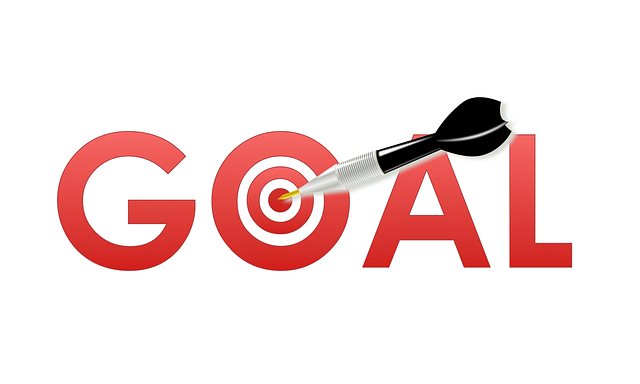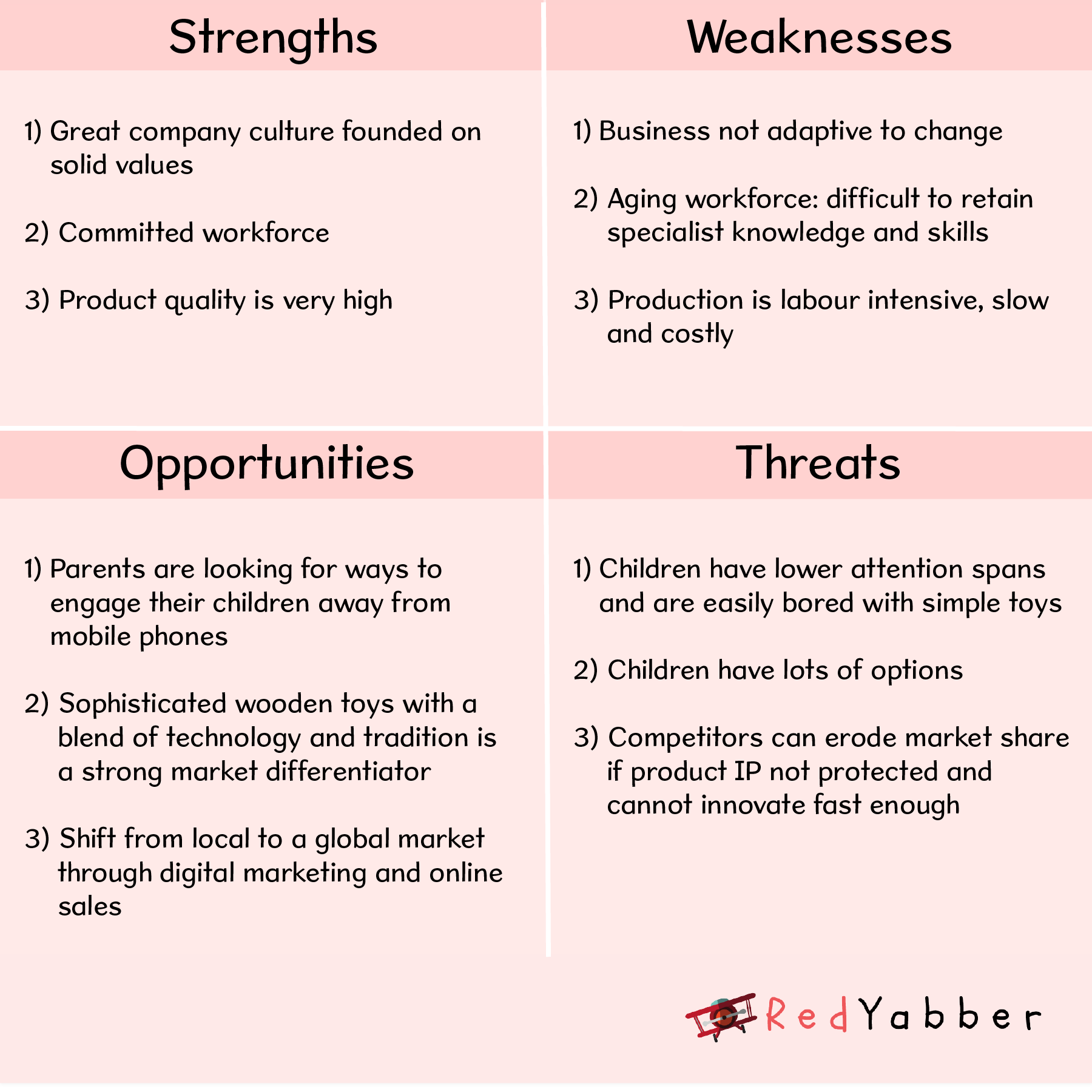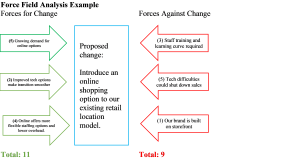17 Stage 2: Analyze
Once data has been gathered and you have gained a good understanding of the challenges and opportunities facing your organization, you can move to the next step- Action planning and Analysis. In this stage of the process you begin to develop the situation analysis for your plan. The situation analysis is a critical section of the PR plan which comes near the front of the document and sets the scene for the framework which follows. This is where you provide the research-based evidence and rationale that will support the goals, objectives, strategies and tactics of your plan. This section of the plan will include:
- Overview of the communication landscape: challenges and opportunities facing the organization

- Summary of the strengths, weaknesses, opportunities and threats (SWOT analysis) in the organization’s environment; a Force Field analysis summarizing issues and opportunities
- Concisely focused problem/opportunity statement
- Target audience analysis
- Review of the organization’s mission, visionand values
- Program goal for the plan
The SWOT analysis
SWOT stands for Strengths, Weakness, Opportunities, Threats. This approach to analysis allows us to visually organize the insights we have gathered in the Research phase of the process so that we can better understand the challenges and opportunities facing the organization.
For each step in the SWOT process list:
- What you know
- What you don’t know (and where you are going to go or who you are going to go to, to get what you know)
- What forces, in each area, will be working with you. Ask yourself how you will maximize those forces.
- What forces, in each area, will be working against you. Ask yourself what you can do to (1) turn these negatives into positives, and (2) neutralize these negatives 3. manage or overcome these negatives
Typically, information included in the strengths category refers to current strengths that the organization can capitalize on in the existing organizational environment. Weaknesses refer to current/existing areas of vulnerability that the organization is facing. Opportunities describe potential or future strengths that the organization may capitalize upon. And finally threats refer to future or potential challenges or weaknesses that may face the organization on the horizon.
In this example, a fictional organization is assessing the communication landscape for strengths, weaknesses, opportunities and threats:

The Force Field analysis
- The Force Field analysis is organizational scholar Kurt Lewin’s method (as cited in Swanson & Creed, 2014) of apprising the organizational landscape, particularly during times of change. This tool is useful for:
- Identifying publics, both those that work towards the organization’s mission and those that work against it.
- Understanding the balance of power in a situation.
- Developing strategies to communicate with each public and when possible to move them along in the continuum from resisting to driving the organizational agenda.
Steps to conducting a Force Field analysis:
- Identify the organization’s current situation
- Identify where the organization would like to be on this issue
- Determine what the situation will be if left alone
- List the driving forces and list restraining forces
- Determine which forces can be changed/influenced
- Give each force a value 1-10, 10 being the strongest force
- Analyze which restraining forces can be weakened and which driving forces can be strengthened.
- Determine which changes can be affected by a PR program
To build the force field framework, construct two columns with a number beside each factor:
- List driving forces that move the situation forward, assign 1-10 number value that reflects strength of this force.
- List restraining forces that hold it back. Assign 1-10 value for strength.

In this example, the research and analysis provided through this Force Field analysis model indicate that the company should consider going ahead with an online shopping option.
The Problem/Opportunity Statement
Based on the insights you have identified using the analytic tools we have just reviewed, you are now in a position to make a clear, concise statement about the core problem or opportunity that your plan will address. This should be a one or two sentence statement that identifies the problem or opportunity you are dealing with, the consequences of not dealing with this issue, as well as the ideal state once this issue has been resolved.
Example: Our organization is struggling to recruit volunteers to staff special events, however, there could be potential to recruit from a local college campus. If we can mobilize these students through a communication campaign, our special events can be more fully staffed.
Target audience analysis
As your analysis begins to focus in on the specific issue the plan will address, information about your target audience is essential. During the research phase of the public relations process you will have gathered data on the demographics and psychographics of key audiences. Demographics refer to statistical data (age, gender, income, etc.) collected for a particular group or population. Psychographics refer to information about attitudes, opinions, and aspirations. Both of these categories of information are key to figuring out which communication channels and tools will reach your audience, and which messages will resonate.
Once you have narrowed down the specific target audience that you wish to connect with, you can tailor your communication objectives and tactics to reach that group most effectively.
Mission, Vision and Values
The next step in the action planning / analysis phase of the plan is to ensure that the direction you have identified to this point is in alignment with the organization’s mission, vision and values. To practice public relations strategically means that all elements of the PR plan are clearly aligned and work to support the mission, vision and values. These three elements provide the compass for organizational decision making, and the road map to where the organization wants to go over the next five or ten years. If the strategies and tactics of the public relations plan are not consistent with this direction, the effectiveness of the program is compromised.
The mission statement of an organization describes its purpose, its core deliverable. The vision statement describes where the organization aspires to be in future, and the values statement articulates the organization’s core principles and ethics. Each of these three elements of the organizational identity offer important direction as to how things are done, what things are important, and what the future will look like.
Here is an example of furniture giant IKEA’s mission, vision and value statements (Source: IKEA.com):

The IKEA Vision
“To create a better everyday life for the many people.” This vision goes beyond home furnishing. We want to have a positive impact on the world – from the communities where we source our raw materials to the way our products help our customers live a more sustainable life at home. By sharing what we do, and speaking up for what we believe in, we can be part of positive change in society.
The IKEA Mission
While our vision tells us why we exist, our business idea tells us what we want to achieve. And if you’ve ever visited IKEA, you’ll have probably worked out what our business idea is – “to offer a wide range of well-designed, functional home furnishing products at prices so low that as many people as possible will be able to afford them.”
- – Ingvar Kamprad, IKEA Founder
The IKEA values
Our values reflect what we consider to be important. So important in fact that we refer to them as one of our “forever parts”. They guide us in our everyday lives at work in everything from how we treat people and the planet to how we make decisions – large or small.
- Togetherness
- Caring for people and planet
- Cost-consciousness
- Simplicity
- Renew and improve
- Different with a meaning
- Give and take responsibility
- Lead by example
Setting the Goal
Based on the research and analysis conducted to this point, you are now ready to construct the goal for this strategic public relations plan. The goal will set the direction for the next stage of the RACE process – Communication. In the hierarchy of communication planning, the Goal is an overall statement of direction with a purpose of setting the “why” for the plan.

Goals define the ‘big picture’ approach to the public relations plan. They should be broad in nature, and they do not need to include specific measurable outcomes (those come in the objectives to follow). They should be challenging but attainable, and they must be rooted in the organization’s mission, vision and values.
Reference
Swanson, D. J., & Creed, A. S. (2014). Sharpening the focus of force field analysis. Journal of change management, 14(1), 28-47.
Publics who receive a specifically targeted message that is tailored to their interests.
Mission statement describes organization's purpose, its core deliverable
Vision describes where the organization aspires to be in future
Values statement articulates the organization’s core principles and ethics
A goal is something that a person or group is trying to achieve.

